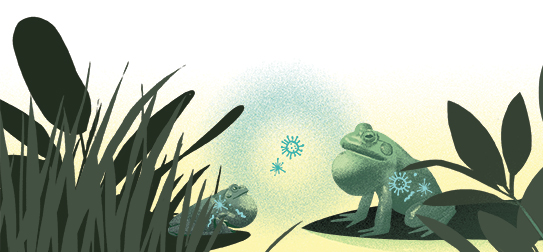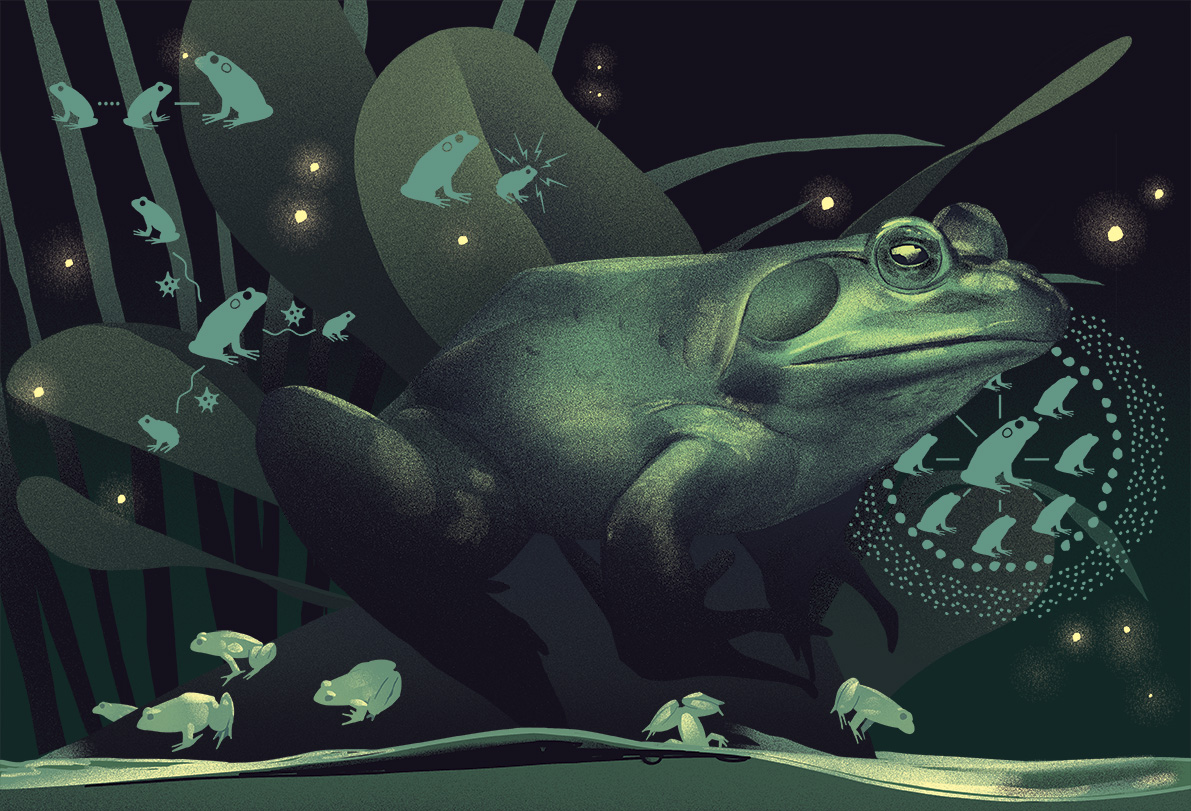It is a quiet evening on Hazel Wolf Wetlands—a wildlife refuge located near Lake Sammamish, Washington. The sun is almost down. The light breeze from the wetland makes me feel chilly. I close my eyes and listen. Conk-la-ree! calls the red-winged blackbird from the bushes. Wibit! Wibit! responds frogs. The place is so calming. It takes me away from the hustle of the city and brings all my thoughts to this pond.
It feels like this pond, surrounded by a quickly and dramatically changing urban landscape, hasn’t changed much in the past centuries. Yet I know this is a deceptive impression. If we only knew where and how to look, we would see the drama of species extinctions and introductions and the intricacies of species interactions unfolding here. We can witness a process that has been shaping life on Earth from the beginning of time.
Ongoing change
Many of us, including myself, used to think about evolution as a process that takes thousands of years. However, sometimes it can occur very quickly, within just a few generations. Scientists even have a special term for it—rapid evolution. As evolutionary biologist Theodosius Dobzhansky once said: “Nothing in biology makes sense except in the light of evolution.” Biodiversity conservation is no exception. If we want to save a species, we have to understand what evolutionary processes it undergoes. Otherwise, the conservation programmes might bring unexpected and undesirable results.
In wetlands such as Hazel Wolf, many native species of frogs and salamanders share their home with the invasive American bullfrog (Lithobates catesbeianus). It was brought to the Pacific Northwest a century ago and reared to consume frog legs. Husbandry farms in the region sunk into oblivion long ago. Bullfrogs have stayed, however. Establishment of exotic species in new habitats that have a negative impact on the ecosystem are called biological invasions. Worldwide, bio-invasions are one of the largest drivers of biodiversity loss. Bullfrogs impact native species of amphibians through predation, competition for food and novel diseases. At the same time, novel interactions between invaders and local ecosystems can give us valuable insights into the process of evolution. We could use these insights to inform more effective conservation efforts.
Let’s take a closer look at our wetlands. They can teach us valuable lessons about evolution and conservation!
Lesson one: It doesn’t take many, or What do the population of bullfrogs and the phoenix bird have in Common?
Whether we want it or not, bio-invasions in a globalised world happen frequently. There is hardly any ecosystem that has not been impacted by invasive species. But how exactly do they happen? And how many individuals does it take to establish a new population? The answers vary greatly for different species.
Imagining bullfrog invasions, I had always pictured hundreds of bullfrogs escaping a frog leg farm. I was mistaken! Astonishingly, as few as six female bullfrogs can start a new colony. Prolific bullfrogs can travel long distances to colonise new habitats, and females can lay as many as 20,000 eggs. All of these make eradicating an established bullfrog population a daunting task. Eradication efforts through trapping are labour intensive, expensive, and often fail— especially when undertaken alone. Take one, and two will come.
Do you remember the mythological phoenix bird—a symbol of immortality and resurrection? Similar to a phoenix rising from ashes, a bullfrog population, once established, resurges again and again. However, it does not mean that nothing can be done to reduce the threat that bullfrogs pose to native animals. If we cannot eradicate them, we can still control their population. Trapping, combined with pond draining or collection of egg clutches can be used to keep bullfrog populations at bay. Prevention, though, is the most effective conservation measure. Knowing that just a few individuals can start a new colony is a good reason not to release pets into a wild pond.
Lesson two: Genetic adaptations to new diseases are key to survival
When bullfrogs establish new colonies far away from their native range, they encounter new predators and diseases. Bullfrogs’ genes that code for immune response to pathogens can reshape quickly to better resist local pathogens, allowing their immune systems to adapt to the new environment. These changes in immune genes are heritable and are a great example of contemporary evolution. This makes bullfrogs successful invaders. Ironically, it also makes them a good vector for spreading diseases.
Contagious diseases are a global threat to amphibians. Amphibians breathe through their skin, so skin diseases can be especially detrimental. Hence, all amphibians have skin secretions that protect them from pathogens. The antimicrobial properties of secretions differ greatly between species. They serve to best protect amphibians from pathogens they have evolved with, offering very little defence against new pathogens.

Chytridiomycosis is a skin disease in amphibians caused by a certain strain of a chytrid fungus. Bullfrogs likely carry the strain of the pathogen responsible for this disease in amphibians. Similar to travellers who might carry and unknowingly spread new variants of disease between countries and continents, invasive bullfrogs can carry and spread chytridiomycosis to previously uninfected ecosystems. Bullfrogs, meanwhile, co-evolved with this pathogen and are more tolerant to it than other amphibian species.
The ability of bullfrogs to spread chytridiomycosis explains why some communities of native amphibians experience more negative consequences than others amid bullfrog invasion. Communities of native amphibians with a different strain of chytrid fungus circulating usually have some level of immunity to chytridiomycosis and are less impacted. But communities that have had no exposure to chytrid fungus are more susceptible to severe declines and extinctions in the event of an outbreak.
For conservation managers, it adds a whole new level of complexity. With intensive efforts, an invasive bullfrog population can be controlled, minimising the impact of predation and competition on native species. But outbreaks of chytridiomycosis are hard to manage and have the potential to decimate entire populations of native amphibians.
Lesson three: It is not only bullfrogs who are adapting to the new environment. Native amphibians are adapting too!
Bullfrogs are voracious predators that will eat everything that will fit into their mouths. Unfortunately, most native amphibians fit the bill. If bullfrogs are present in the ecosystem, native amphibians have to find ways to avoid predation. Those amphibians who are more successful in avoiding predation and competition for food will have a better chance of reproducing.
Many species of frogs can ‘scent’ chemicals of predators they co-evolved with. However, if a predator is a new and unfamiliar species, it won’t be recognised as a predator. For example, in ponds where a population of bullfrogs has been present for decades, tadpoles of California red-legged frogs (Rana draytonii) could detect their presence nearby and take shelter, but tadpoles from ponds free of bullfrogs did not exhibit the same behaviour. Interestingly, this behaviour is heritable.
This provides a glimmer of hope for the conservation of native amphibians, while also raising many questions that are yet to be answered. For example, can the population of native frogs be “taught” how to avoid bullfrogs? In theory, a relatively new conservation strategy called ‘targeted gene flow’, might benefit some species of native amphibians facing the bullfrog invasion. It involves the translocation of individuals with a favourable trait to populations that will benefit from this trait. The introduction of native amphibians who can already ‘smell’ bullfrogs and avoid them in a bullfrog-naive population can help the latter acquire this desired genetic adaptation.
Lesson four: Strong sexual preferences can lead to big troubles
Yes, you read it right. Males of red-legged frogs and Oregon spotted frogs (Rana pretiosa) prefer larger females for breeding. Who can blame them? In a harsh natural world, reproductive success is the main measure of success. Larger females mean more offspring. Mating with more fecund females has always been a beneficial strategy for males. At least, until bullfrogs arrived. Juvenile bullfrogs slightly resemble mature red-legged frog females, with one caveat—they are bigger. This makes them more attractive and almost irresistible to male red-legged frogs.
Not surprisingly, males are reluctant to mate with females of their own species. Instead, male red-legged frogs favour young bullfrog females. It is detrimental to reproductive success, as no offspring could be born from such courtship. It also puts males in great danger because mating with juvenile bullfrogs usually lasts longer—this might sound like a good thing in some circumstances, but not in a pond full of predators. Longer mating time increases the chance of males being eaten by adult bullfrogs or other predators. This behaviour poses a problem for conservation. With an increase in the number of bullfrogs in the habitat of Oregon spotted frogs or red-legged frogs, the higher the chances of males preferring to mate with juvenile bullfrogs, and sharper the population decline.
The sun sets in the Hazel Wolf Wetlands. As soft downs envelop the landscape, I reflect on how everything is interconnected, and how complex yet delicate the natural world is. I think about the ongoing changes in Hazel Wolf, how amazing bullfrogs are in their ability to adapt, and the whole new level of complexity that the evolutionary perspective brings to conservation.
It turns out that invasive bullfrogs impact native communities not only through predation and competition, but also by spreading new diseases and disrupting the reproductive process. We have to address these new threats to protect local ecosystems. If we fail to consider contemporary evolutionary processes in amphibian conservation programmes, the results of these programmes might be different from the expected outcomes.
Further Reading
Anderson, R. B. and S. P. Lawler. 2016. Behavioural changes in tadpoles after multigenerational exposure to an invasive intraguild predator. Behavioural ecology 27(6): 1790–1796.
D’Amore, A. N, E. Kirby and V. Hemingway. Reproductive interference by an invasive species: an evolutionary trap. Herpetological conservation and biology 4(3): 325–330.
Yap, T. A., M. S. Koo, R. F. Ambrose and V. T. Vredenburg. 2018. Introduced bullfrog facilitates pathogen invasion in the western United States. PLOS ONE 13(4): e0188384.
Originally published on 13 May 2024






